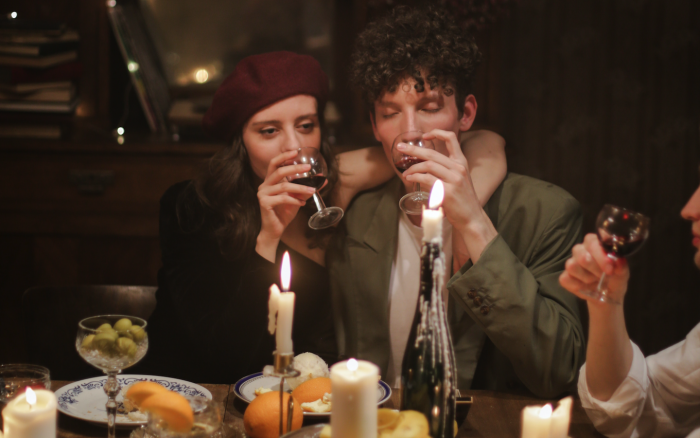Hygge is presence and intention—and we need it more than ever.
Hygge: pronounced “hue-gah.”
The word is Danish and regarded as defining of my culture, which is, yes, Danish. Hygge is used as both an adjective and a verb. For example, an event or a place can be “hyggeligt” or people can “hygge” together.
Hygge defines a special, warm, kind quality of coziness, presence, and comfortable conviviality that gives everyone present a feeling of belonging and safety.
As a native Dane, I want to tell you in more detail what it is and why it might be the key to us Danes’ consistent rank as the happiest people in the world.
I am convinced it’s because we know how to hygge and do it a lot—and when we don’t, we miss it very quickly.
So what is this elusive quality that is so healing and so nurturing?
Well, hygge has become a buzzword in the United States, and most of what I hear called hygge (no, you can’t call a moisturizer “hyggeligt”) is not really it.
So why is it so hard to get the concept across? It’s such a deeply ingrained part of our people—this Nordic tribe who makes it through a long and dark winter by huddling around fireplaces and, short of that, candles, many, many candles.
But it’s more than that. It’s an attitude of realness and presence, genuine caring and empathy and a concern for the welfare of all, and just a little less of an emphasis on the promotion of self.
The ultimate expression of this is, of course, our political system; it doesn’t allow anyone to go hungry or without medical care and education. But in the day-to-day, it’s expressed as this quality named Hygge.
It’s like an energy that permeates the tribe and the cities and countrysides. Like it’s all created first and foremost for people, not for economic growth. The beauty of the landscapes, the care for the old buildings, and the cobblestones that divide the sidewalks.
Allow me to share some hygge practices with you and show you how you might bring more hygge into your daily life and relationships:
1. Be present, relaxed, and real.
So, what do I mean by that? It’s a gaze. Not a flirty gaze or a stare, it’s how you look at someone else—like you mean it.
Like this:
You matter to me. I want to know you, and I am interested in who you are and what you think. I will not talk over you with my own story or quietly plan what I am going to say when you shut up. I am going to give you my full and complete presence.
This is the greatest gift we have to give each other. The “I am here.” I am right here, and I am listening to you—feeling you.
I am not worried about my phone messages or my work or anything but the people I am hygge-ing with—right here, right now.
2. Create spaces dedicated for hygge-ing.
Lighting is important. Low light; not harsh, overhead light. Candles. Must have candles. Splurge and get beeswax or economize and get Ikea’s white tapers. Don’t get scented candles (that will destroy the hygge vibe instantly).
Plants. Love your plants so that they put good vibes into your hygge nooks. Get fresh flowers in the spring. Lilacs. Start by making your kitchen eating area the coziest ever. Everyone can sit. No bad chairs.
No TV or radio blaring. Just conversation and food-cooking—slowly. Help chop something. Let it sizzle. Let the scent fill the room and ask questions. Like you really want to know another person whether it’s a family member, an old friend, or a new friend. Like we are the most interesting, amazing miracle to each other, right here.
3. Take long walks outside.
Dress for the weather. Be outside anyway. Breathe in the fresh air, the sea, the woods, lakes, mountains, whatever nature is near you. Find it and take it in. Let the fresh air and many, many miles of walking tire you out.
Then comes the reward: the indoor hygge. The candles, the warm tea, the fresh-baked buns or bread. Good butter. From pasture-fed cows. Did you know that all cows must be out in the pasture in the summer in Denmark? So when you buy non-organic milk (which hardly anyone buys anymore), it’s from pasture-fed cows.
Isn’t that hyggeligt? Not stuffing cows in barns to never see the sun for as long as they live. But I digress; you just got back from the long walk outside.
Now, it’s time to rest your tired body in front of the fire, if you have a fireplace, otherwise candles. Many candles, preferably.
Something nourishing to eat—homemade, baked, made with love and patience, and ready for you, the guest, because I am so excited you are here, and I want to know you, and I want you to know me.
How are you? What is going on, and how does that make you feel?
4. Have dinner together.
Set the table really nicely. Use real glasses—never plastic. Get glasses at a second-hand store if you want to save money, but, please, don’t buy plastic. (No matter how many guests you have.)
Get real glasses and wash them up—together—later, while you chat and drop in and be present with each other. Set the table with nice plates, silverware, flowers (make it pretty!), maybe pine cones from your walk, or funny shaped rocks from the beach that the kids picked up and brought home in pockets full of sand. Put some thought into who sits where.
Why are these people at your house? Who do you think they would each really like to sit next to?
Direct the seating arrangement like it matters. Tell people what you cooked and why. You put thought into it. Or maybe it’s a potluck! (That’s hyggeligt too.) Love and care went into this food.
Eat slowly and allow the conversation to be just as much a part of the nourishing meal as the food itself. If you are the host, make sure everyone is heard. Be interested in all your guests. As a guest, be so very interested too.
Who is this person that my host sat me next to? Can me getting to know them be more important than me impressing them with who I am?
Low lights. Candles, candles, candles. And time. No one is in a hurry.
This is the meal. This is our time together, and we are here to laugh, talk, discuss, sometimes we even debate politics and such. And it’s okay if we don’t agree. It’s just politics. It’s not the end of the world. It’s not polarizing; it’s more of an elegant, fencing type of thing going on.
Who can recall more historical, cultural, economic facts?
Okay, now the hygge is leaving the room, don’t get too intense in your political debating. Return to taking an interest in each other—the soft side of life.
How are you? What’s really going on?
Relax and laugh. You are not here to “entertain.” You are here to be together.
When you can be together and feel safe with each other, you can relax deep inside. You digest your food better and become less self-conscious.
You may even forget about your own neuroses for a while as everyone is immersed in togetherness—total emotional and physical safety.
That’s hygge.
And we can give that to each other and ourselves.









Read 11 comments and reply